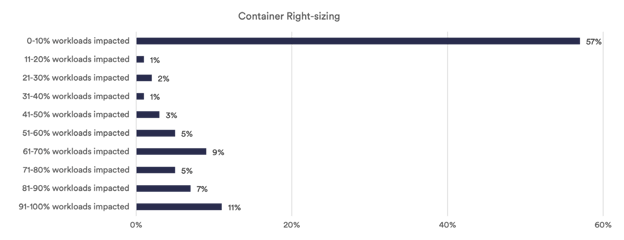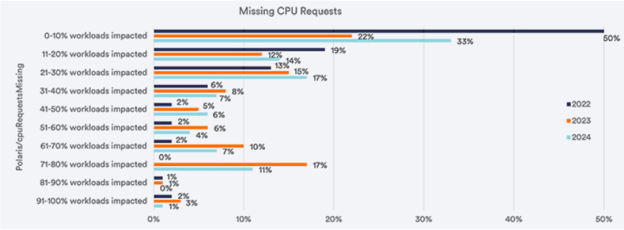Kubernetes Benchmark Report: Managing K8s Workload Costs in 2024
Digital transformation and shifting to the cloud continue to be priorities for most organizations. According to Flexera’s 2023 Tech Spend Pulse, 75% of respondents indicated that cloud and cloud migrations are their top priority for the year ahead. Digital transformation is top of mind for 74% while 76% are most concerned about cybersecurity. In this shifting environment, managing cloud and Kubernetes costs remains a challenge for many organizations. According to the 2024 Kubernetes Benchmark Report, one third of organizations still lack container rightsizing.
Fairwinds analyzed current trends based on data from hundreds of organizations, analyzing over 330,000 workloads. We compared the latest information from 2023 to the data from 2022 and 2021 to create the 2024 Kubernetes Benchmark Report. To no one’s surprise, while Kubernetes adoption continues to grow, challenges remain for many organizations. Unfortunately, lack of alignment with best practices results is all too likely to result in cloud cost overruns, undiscovered security risks, and reduced reliability.
Container Right-Sizing
To make sure your Kubernetes clusters are as efficient as possible, it’s important to set resource limits and requests properly — and go back to adjust them if or when needed. The focus for cost efficiency has always been primarily on missing memory and CPU requests and limits. In past years, we looked closely at this data because container right-sizing focuses either on improving reliability or improving resource utilization and efficiency. This year, we focused on the broader question — does the container need to be right-sized or not?

Using this approach, we found that 57% of organizations have 10% or fewer workloads that require rightsizing, which means that the majority are making appropriate adjustments based on the unique needs of their organization and their apps and services over time. However, 37% of organizations still have 50% or more workloads that need some degree of investigation when it comes to container rightsizing. As cloud spend numbers continue to grow, it’s important to keep a close eye on efficiency and find areas to make improvements to avoid unnecessary spend.
Missing CPU Requests
For Kubernetes to schedule pods appropriately, CPU and memory requests must be set. You can enforce this Kubernetes best practice using policies and guardrails to make sure that devs are actually setting requests and limits. Applying these policies consistently can help you avoid issues related to missing CPU and memory requests. Unfortunately, the 2024 Kubernetes Benchmark Report showed that missing CPU requests is still a widespread issue impacting a significant number of workloads.

Monitor and Manage Costs Across Kubernetes Clusters
By addressing container rightsizing changes at the pull request, your organization can realize multiple benefits, including:
- Save costs: avoid wasting Kubernetes compute by rightsizing workloads before they are deployed to production. If your organization is running large Kubernetes clusters or running many clusters, this shift can lead to significant cost savings.
- Reduced cost of fixing: if you can get alerted of overprovisioned workloads while infrastructure-as-code is still in development, the cost of making a resource change is significantly lower.
- Performance improvements: when you ensure that each workload has the resources it needs to run efficiently, the result is faster response times, fewer errors, and a better user experience.
- Reliability improvements: under-provisioned workloads — that is, workloads with too little memory or CPU requests — can increase the potential for outages, performance degradation, and out-of-memory errors (OOMKills). You can increase reliability by rightsizing your workloads and monitoring for OOMKills with a solution like Fairwinds Insights.
Kubernetes Workload Costs in 2024
As organizations shift more apps and services to production Kubernetes environments in the cloud, keeping a close eye on how much resources workloads are consuming remains important. At the same time, it’s vital that these workloads remain reliable and available. In the year ahead, organizations should make sure to:
- Identify areas where CPU and memory spend is excessive
- Get insights into when adjustments are needed and how to make the right changes
- Reduce cloud spend costs without negatively impacting performance
Read the full 2024 Kubernetes Benchmark Report to learn more about these results and investigate trends in workload security and reliability over the past year.
Read the complete Kubernetes Benchmark Report today.


